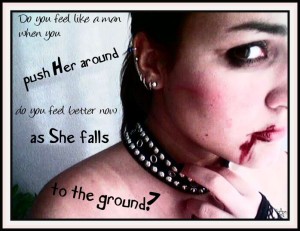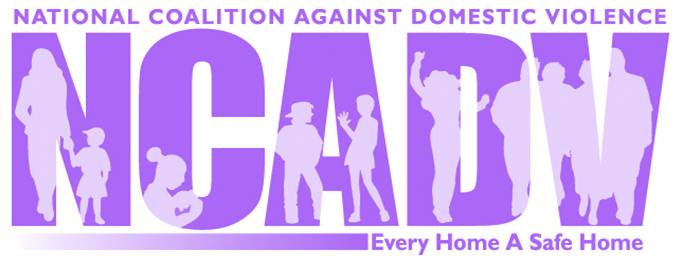 “I just could not understand the rage in the beginning. It was like the harder I tried to be perfect, the angrier he would become. I was beautiful–the perfect wife, perfect mother, perfect in my job, and kept a perfect home. What was I doing wrong to make him act this way, threaten me, and scream at me until he frothed at the mouth with ire?” – Dr. Gayle J. Hall.
“I just could not understand the rage in the beginning. It was like the harder I tried to be perfect, the angrier he would become. I was beautiful–the perfect wife, perfect mother, perfect in my job, and kept a perfect home. What was I doing wrong to make him act this way, threaten me, and scream at me until he frothed at the mouth with ire?” – Dr. Gayle J. Hall.
The first time I noticed hostility or minor violence was one evening when we, as a couple, were preparing dinner together. We were not married yet, nor living together, and were in kitchen of my home making a meal. He was chopping tomatoes for a salad and as he was speaking about his ex-wife, he started chopping harder and harder with the chef knife. I asked him politely to have a seat and let me finish preparing the meal. That one statement made him angry. He picked up the oval platter that was a gift to me from a dear friend, slammed it down into the sink, and told me to “shut up.” My prized platter was chipped beyond repair and I was frightened of this man I thought I loved. The next day, I broke up with him. He begged forgiveness, told me it would never happen again, and I took him back. Three months later, we were married. Four days after our wedding, I experienced domestic violence in the full realm, although at that time, I still had no clue what or why this was happening to me. My new husband chased me from the minute he got home from work, while screaming profanity and calling me a whore, in my home for hours. He later apologized. I so was exhausted that I finally went to bed. I woke up in the wee hours of the morning because I could not breathe. He had a pillow over my face and was trying to smother me, as he was laughing. He stood up in the bed and hovered over me, threatened to make me quit my successful advertising company, and demanded that I never speak with another man. I was pregnant with his child. I knew right then that I would divorce this man that I had just married. This was the beginning of a very long seven-year marriage. Yes, this story I just told you is one of many nights of terror, as I lived in a relationship laced full of domestic violence. I had no idea this could ever happen to someone like me, a loving, peaceful, happy woman.
Regardless of the type of domestic violence occurring in the home, there are three distinct phases, coined by the pioneer L. Walker, as the “Cycle of Violence.” These are the tension building phase, the acute phase, and the final phase. The following paragraphs provide brief descriptions of each phase.
1). The first phase in the cycle of violence is tension building, otherwise known as “walking on eggshells” for the battered woman. She never knows what may set her partner off in a rage. The woman is on high alert at all times, because she cannot do anything right. If she has cooked a perfect meal, her abuser may be angry because he wanted to take her out to dinner. If she waits until he gets home to ask him what he would like for dinner, the abuser may be angry or become violent because she is supposed to know what it is he wants for dinner. The abuse may be emotional, psychological, or verbal threats, such as mocking, screaming, yelling, manipulation, humiliation, or threats to leave. Sometimes, there may be minor physical violence during the tension-building phase. This phase may last for hours, or even days.
2). The second phase in the cycle of violence is known as the acute phase. The batterer may become extremely violent, either sexually or physically. The victim may be denied sleeping or eating. She may be tied up or restrained, locked up in the home, chased down by a vehicle if she escapes the home, beaten, choked, have broken bones, or be assaulted with a weapon. This is the shortest of all phases in the cycle of violence.
3). The final phase in the cycle of violence is the calm phase, otherwise known as the honeymoon period. The abuser is charming, promises to never hurt the victim again, may buy gifts and seem remorseful. He may ask for forgiveness. The abuser has very often even acted like nothing ever happened in the first place.
It needs to be noted that although each couple's story may be different or unique, the cycles of violence are not. As the duration of the relationship progresses, the cycles become shorter and occur more frequently. The victim is most likely to ask for help from family members or clergy, before seeking professional help. If she does ask for help, it is most likely to transpire during the honeymoon period.
Drugs and alcohol may make violence worse, but they do not cause abuse. Many batterers are sober, yet they still degrade, harm, or beat their partners. I have been free of that domestic violent relationship for 15 years. My abuser was a miserable alcoholic, hateful husband, and pathetic, terrible father.
Please read the previous, second article in this series of six on domestic violence titled, “DV: Descriptions of Physical, Emotional, and Psychological Abuse—Part Two, in a Series of Six.”
Watch for the fourth article in this series of six on domestic violence titled, “Domestic Violence: A Few Signs of Domestic Violence You Cannot Ignore—Part Four, in a Series of Six.”
©Copyright — Gayle Joplin Hall, PhD. All rights reserved worldwide. None of this material may be downloaded or reproduced without written permission from the author.















There are three phases in the cycle of violence, always. To a person who is unaware of domestic violence, these phases are not evident; however, they are always there during a battering incident.
Over the course of time in an abusive relationship, the “in-between-period” of violence will become shorter and the cycle of violence will repeat itself more often. The severity of violence varies from couple to couple.
My article series discusses the “victim or battered woman” as a female and the “abuser or batterer” as a male. This is because research, data, and evidence has indicated that in 95% of all cases of domestic violence, the one who is abused is a female and the one who is the batterer is a male. There are instances where the victim is the male and the batterer is the female. Nonetheless, it should be noted that domestic violence occurs with same-sex couples, also.
If a victim of domestic violence came to you asking for help, what would you do? How would you help, or would you? Has anyone ever approached you for help and how did this make you feel?
Please feel free to leave your comments. Thank you for sharing!
Shining my love into your world, Dr. Gayle J. Hall